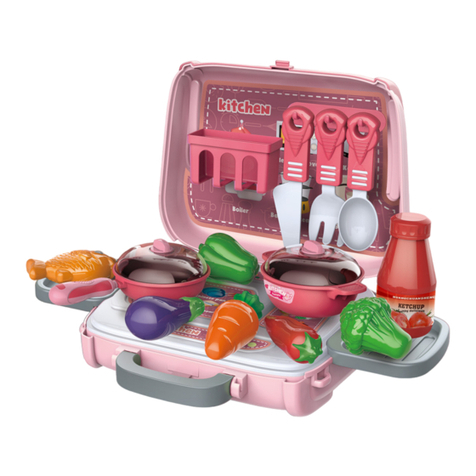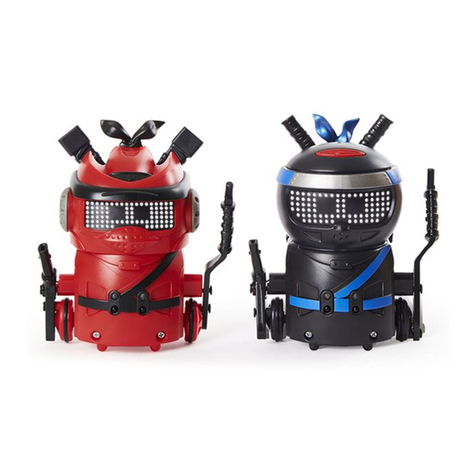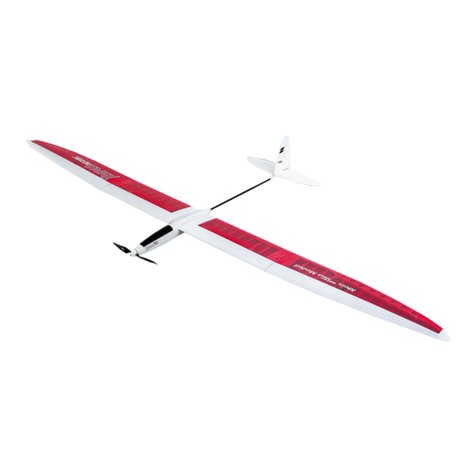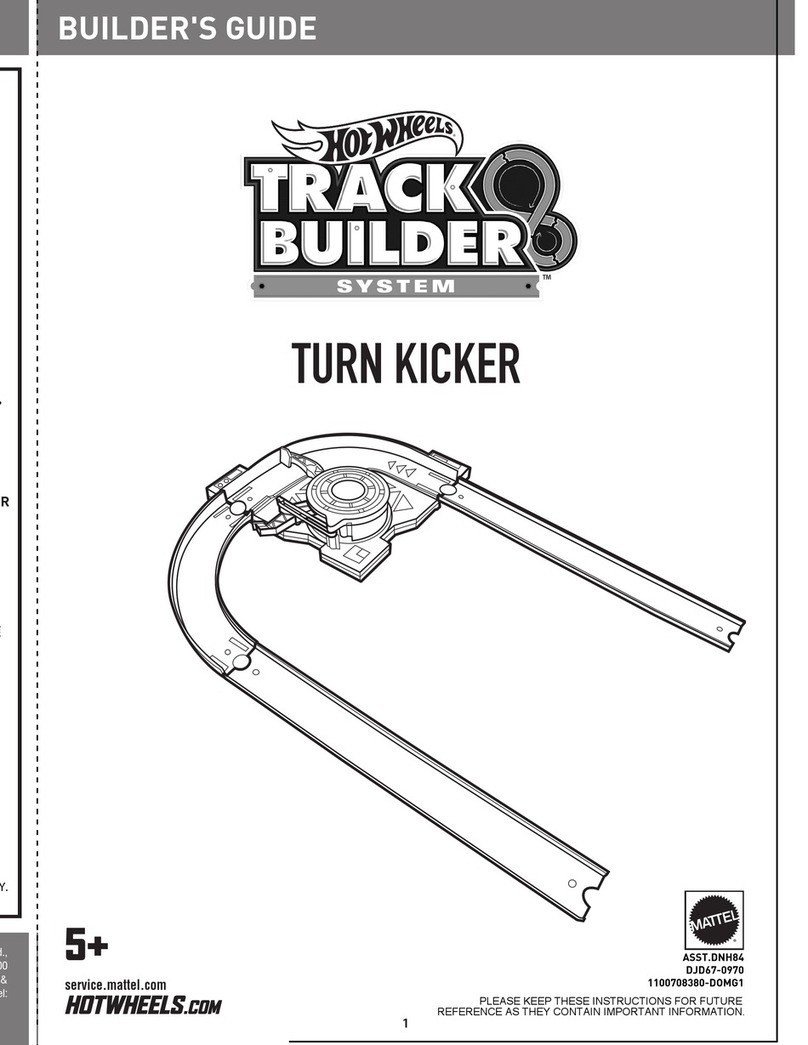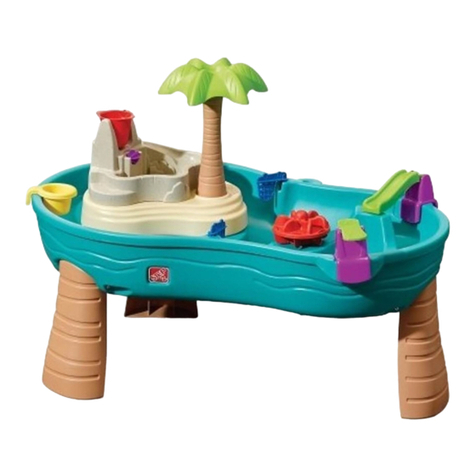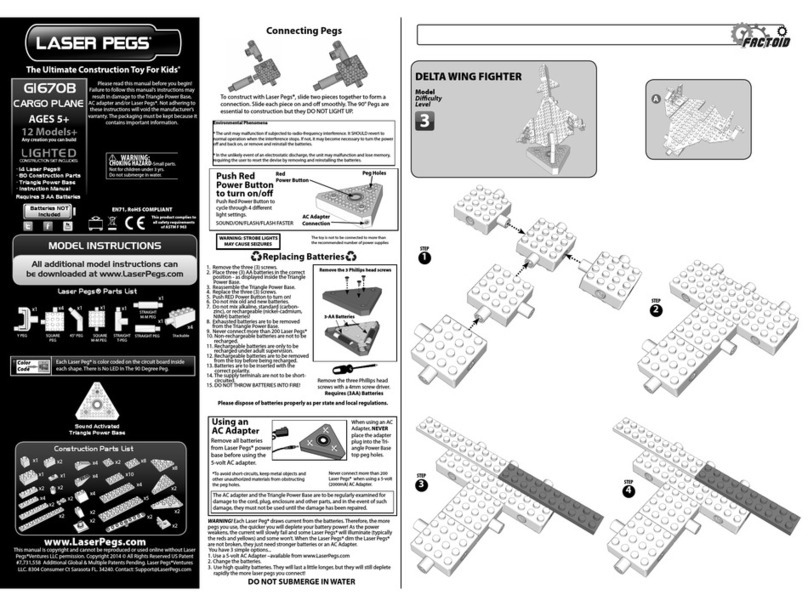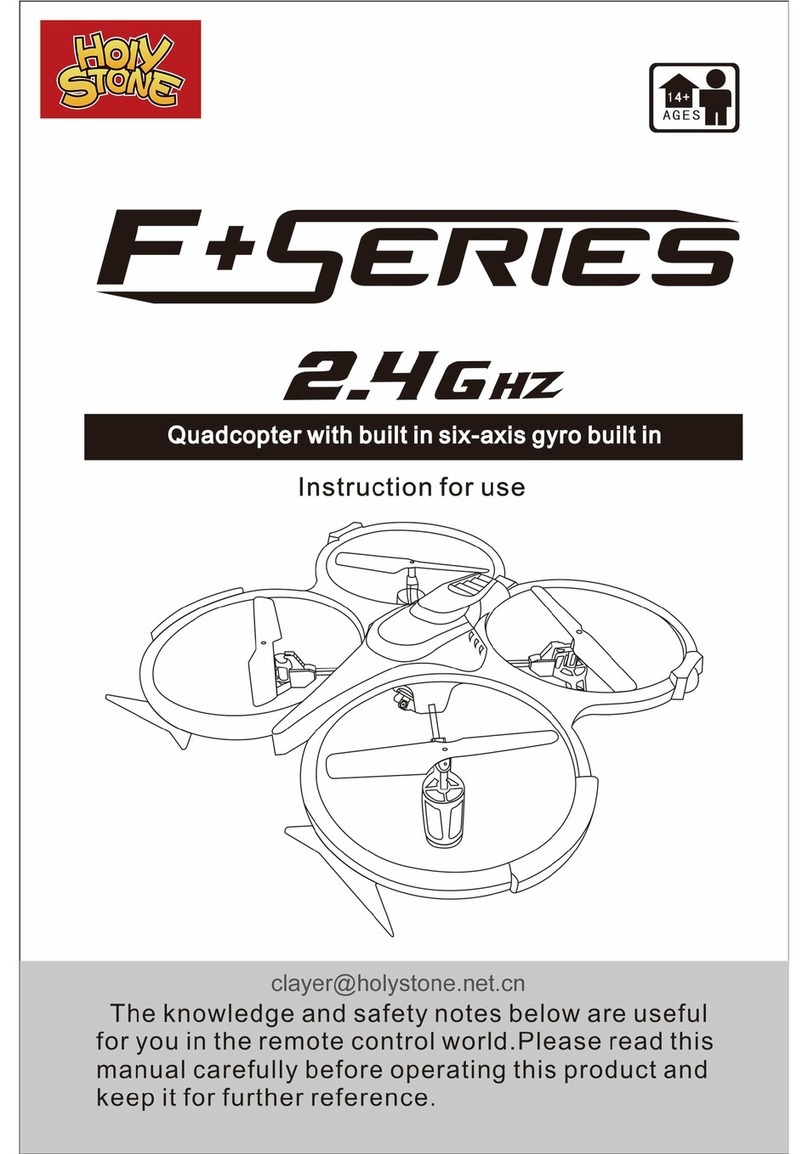Eclipse 650 User manual

(25.6”)
Specifications
Hull Width 135 mm (5.3”)
Hull Length 650 mm (25.6”)
Mast Height 950 mm (37.4”)
Total Height 1365 mm (53.75”)
Weight 1.35 kg (47.62 oz.)
Batteries 8 AA (included)
Servos Sail winch servo and rudder servo
Quick Start Guide


AGE RECOMMENDATION: NOT FOR CHILDREN UNDER 14 YEARS, THIS IS NOT A TOY.
As the user of this product, you are solely responsible for operating in a manner that does not
endanger yourself and others or result in damage to the product or the property of others.
▪Always keep a safe distance around your model to avoid collisions or injury. This model is
controlled by a radio signal subject to interference from many sources outside your control. Inter-
ference can cause momentary loss of control.
▪Always operate your model in open spaces away from full-size vehicles, traffic and people.
▪Always follow the directions and warnings for this and any optional support equipment (chargers,
rechargeable battery packs, etc.).
▪Always avoid exposing the electronic parts of this model to water. Moisture causes damage to
electronics.
▪ Never operate your model with weak transmitter batteries.
▪Always keep you model in sight and under control.
▪Always use fully charged batteries.
▪Always keep transmitter powered on while vehicle is powered.
▪Always remove batteries before disassembly.
▪Always keep moving parts clean.
Introduction
Whether you’re a first timer or have years of experience as an RC boating enthusiast, the Rage
RC Eclipse 650 sailboat is the ideal sailboat for you. The Eclipse 650 hull is blow-molded from
ABS for added durability and the attractive pre-applied trim design gives it the look of a full-size
sailboat when you’re sailing your local lake or pond. For convenience, the Eclipse 650 arrives
pre-assembled with the sails partially pre-rigged to help make getting on the water fast and easy.
Plus, it’s the ideal size to fit in either the back seat or trunk of your car for heading to your local
body of fresh water. For performance, the Eclipse 650 includes a 17g “drum-style” winch servo
that provides power and smoother, more scale-like operation than traditional servos.
The Eclipse 650 is a RTR boat, so everything you need to get started is included in the box -
including a 2.4GHz interference-free radio system, a “drum style” sail winch servo, and pre-printed
rip-stop nylon sails that provide durability and performance. The Eclipse 650 even includes the 8 AA
batteries needed for operation - 4 for the transmitter and 4 to power the servos, plus an easy to
assemble display stand to show off your new sailboat when you're not out sailing.

4 / 16
.
Box Contents
1
2
3
4
4
4
4
5
67
89
10
11
12
13
14 15 16
17
19
18
20
21
23
22
24
25
26
1. Hull
2. Transmitter
3. Ballast
4. Display Base
5. Keel
6. Short Mast
7. Rudder
8. Backstay Rigging
9. Long Mast
10. Jib Sail w/Boom
11. Main Sail w/Boom
12. HM5x25mm Screw
13. HM5x50mm Screw
14. Luff Rings (3)
15. PWA 2x10x8mm (2)
16. Clip (Rudder)
17. Rubber Gaskets (2)
18. Dyneema Cord
19. Forestay Fitting
20. Cord Holder
21. H2.0mm Allen Key
22. H4.0mm Allen Key
23. Metal Backstay Crane
24. Rudder Arm
25. Clevis’s (pre-installed)
26. Bowsie’s (pre-installed)

5 / 16
=
2. Put together the keel, the water-proof rubber
gasket, and the ballast as shown and fasten with
the 5x25mm screw by using the included 4.0mm
allen key.
3. Attach and secure the keel and water-proof
rubber gasket to the hull using the 5x50mm
screw and the 4.0mm allen key.
4. Insert the rudder through the bottom of the hull
to the deck and through the rudder arm. Connect
with a clip making sure the rudder is able to rotate
freely. Then, insert the push rod through the
connector on the rudder arm. Make sure the rudder
is centered and tighten the allen screw with a
2.0mm allen key.
5. Install the cord holder to hull deck with two
PWA 2x10x8mm screws.
6. Unroll main sail and install 1 Luff ring in each
of the three grommets. Slide the long mast through
1. Assemble the display base as shown
in the diagram by inserting the tubes into
the sockets. There's no need to glue the
parts together.
Assembly and Rigging Instructions

7. Insert long mast through main boom and into
the hull. Ensure the mast screw engages the
main boom slot.
6 / 16
8. Connect long mast, forestay fitting part and
short mast together.
10. Assembly should look like the drawing above.
Please note that the sail does not need to be
connected to the rear mounts of the swivel.
45mm
210mm
120mm
15mm
65mm
110mm
165mm
9. Raise the sail and place the plastic swivel
on top of the short mast. Insert the metal
backstay crane through the swivel and into
the mast.
Your Eclipse 650 sailboat comes with the sails already attached to the main and jib boom.
These drawings are only a reference as to the approximate location of the silicone rings.
SR1
SR2SR3
SR4SR5SR6
SR7

11. Locate the approx. 40” long length of
rigging. Attach the clevis tothe metal backstay
crane and the other end tothe rear eyelet on
the hull. The end with the adjustment bowsie
should be closer tothe hull.
12. Unroll the jib sail and untape the clevis
from the top of the sail.
7 / 16
SR5 SR4 SR1
SR2
SR3
13. Hook the clevis to the forestay fitting
keeping the eyelet pointing toward the bow
of the boat.
14. Unhook the eyelet from the deck hook and
attach it tothe front silicone ring on the jib boom.
Slide the bowsie totighten the line in order to
position the jib in front of the main mast.
15. Untape the line from the jib and thread
it through the 3 deck eyelets as shown in the
drawing above. Slip the loop at the end of the
line onto the clevis that is pre-installed by the
rear hatch and is attached tothe winch servo.
16. Untape the line from the main sail and thread
it through the cord holder and 1 deck eyelet as
shown in the drawing above. Slip the loop at the
end of the line onto the same clevis as the
previous step.

8 / 16
17. Now that you have completed the basic assembly of your sailboat, some adjustment of the
rigging may be necessary. Please refer tothe instructions below.
(1) Silicone ring 1 on the main boom can be adjusted totighten the main sail. Leave a little
slack in the sail sothat it can catchthe wind. Generally, in strong wind conditions the
sail needs more slack and in gentle conditions it can be tighter.
(2) Silicone ring 2 is used to adjust the line length tokeep the main boom in center position.
If it is too tight, move it toward SR3. If too loose, move it toward SR1.
(3) Normally SR3 will not need to be moved, it should stay in position over the cord holder.
SR7 SR6 SR5 SR4
18. Some adjustment of the Jib boom rigging may be necessary. Please refer tothe instructions
below.
(1) Silicone ring 4 on the jib boom can be adjusted totighten the jib sail. Leave a little
slack in the sail sothat it can catchthe wind. Generally, in strong wind conditions the
sail needs more slack and in gentle conditions it can be tighter.
(2) Silicone ring 5 is used to adjust the angle that the jib extends to when the sail winch is
all the way out. Make sure that the jib sail can travel a larger angle than the main sail.
Normally the jib sail travels about 90°-100° while the main sail travels 80°-90°. If the angle
is toosmall, move SR5 toward SR4. If the angle is too large, move SR5 toward SR6.
5mm - 8mm
30mm - 35mm
(3) If the jib rigging to the winch is too tight move SR6 toward SR5. If it's too loose, move SR6
toward SR7. The jib boom should be able to move about 30-35° when the main sail is fully
hauled in and the sail control stick on the transmitter is in its lowest position.
(4) To adjust the distance between the jib boom and the main mast, move SR7 as follows. If
there's too large a gap move toward the counterweight. If the gap is too small, move toward
SR6. There should be approximately a 5mm-8mm gap between the jib boom and the mast.
90° - 100° 80° - 90°

19. The counterweight on the front of the jib boom is to adjust its balance. It should balance with
the CG (center of gravity) on SR7. To balance the boom, the counterweight can be easily moved
either in or out as needed.
9 / 16
21.Move the bowsie attached
to the jib sail grommet to
tighten or loosen the jib sail.
22.Move the bowsie at the
rear of jib sail to tighten or
loosen the jib sail leg.
23.Move the bowsie on the
foredeck to adjust the
distance between the jib
boom and deck.
20. Move the bowsie on the
front jib sail rigging to maintain
a slight bend in the mast. The
dotted line in the drawing to
the right is an exaggerated
example of what the bend
should look like. The actual
bend should be less
pronounced than the drawing
shows.

10 / 16
LED
Binding Instructions
Binding is the process of programming the receiver to recognize
the GUID (Globally Unique Identifier) code of a single specific
transmitter. When a receiver is bound to a transmitter, the
receiver will only respond to that specific transmitter.
The Eclipse 650 comes with bound Transmitter and Receiver.
If you need to rebind for any reason, please follow these steps:
1. With the transmitter switched OFF.
2. Power on the receiver, then turn on the transmitter within 5
seconds.
3. The receiver LED will blink from 3-5 seconds while binding
automatically.
4. When the LED stops flashing, binding is complete and the
Eclipse 650 is ready to run.
Antenna
Loosen this screw
Power - Channel ELEV
Rudder Stick - Channel AILE
Sail Stick - Channel THRO
24. Move the bowsie attached to
the main sail grommet to tighten
or loosen the main sail.
26. Loosen the screw on the
arm of the main boom to
adjust the height of main
boom. This adjustment is
typically not needed.
25. Move the bowsie on the
main sail backstay rigging to
maintain a slight bend in the
mast. The dotted line in the
drawing to the far left is an
exaggerated example of what
the bend should look like.
The actual bend should be
less pronounced than the
drawing shows.

The Eclipse 650 comes with a 2.4G 4-channel radio system. For sailing you will only need 2 channels.
Before sailing become familiar with all functions listed below:
1. The sail stick controls the maximum angle of the main sail and jib sail. When you move the sail stick
to the upper position, both sails will expand as the wind impacts the sails. Both sails will expand to the
left or right depending on the wind direction.
2. The rudder stick controls rudder movement to the left or right.
3. Sail trim / rudder trim switch allows you to adjust the neutral position to center the of sail / rudder,
as needed.
Dual Rates
Rudder Stick
No Function
Rudder Trim
Power Switch
Power LED
No Function
Sail Stick
No Function
No Function
11 / 16
Transmitter Functions
Sail Stick Move Up
Sail Stick Move Down
Sail Stick Move Up
Sail Stick Move Down
Rudder Stick Move Left
Rudder Stick Move Right

12 / 16
Wind Abeam
Sails: Expand both at an
angle of 45° at port side
Rudder: In center position
Quarter Lee
Sails: Expand both sails
at a greater angle
Rudder: Turn to the left
Starboard Tack-Running
Sails: Expand both sails
at max. angle at both
sides
Rudder: In center position
Port Tack-Running
Sails: Expand both sails
at max. angle at both
sides
Rudder: In center position
Quarter Lee
Sails: Pull back both sails
at starboard side
Rudder: In center position
Luff Up
Sails: Pull back both sails
gradually
Rudder: Turn to the left
Wind Abeam
Sails: Expand both at a angle
of 45° at starboard side
Rudder: In center position
Luff Up
Sails: Pull back both sails gradually
Rudder: Turn to the left
Port Tack
Sails: Keep pulling back
both sails
Rudder: Keep turning
to center position if the
sails stop flapping
Tack
Sails: Keep pulling back
both sails
Rudder: Turn to the left
Tack
Sails: Keep pulling back
both sails
Rudder: Turn to the right
Tack
Sails: K eep pulling
back both sails
Rudder: Turn to the left
Bearing Away
Sails: Expand both sails
keeping them from flapping
Rudder: Turn to the left
Starboard Tack
Sails: Keep pulling back
both sails
Rudder: Keep turning
to center position if the
sails stop flapping
45°
Sailing Instructions
IMPORTANT NOTICE:
1. Never sail in running water such as streams or rivers, as it is easy to lose control.
2. Never swim after a stalled or stuck boat. Wait patiently for the wind currents to run the boat again so
that you can return it to a location where it's easier to retrieve.
3. After running, remove the hatch to allow the interior of the boat to completely dry. Neglecting to take
this step, could result in the corrosion of the electronic components.
RC sailing presents a more interesting set of challenges than power boating. Sailing requires a constant
reaction to water movement and wind conditions. These reactions require adjustments to both the rudder
and sails in order to find the best possible setting for speed and course. There is no substitute for actual
“on-the-water” experience, so after a couple of sailings you may want to read through the manual again
as you gain a better understanding of the art of sailing. As you learn, it's a good idea to become familiar
with sailing terminology which will make it easier to understand the concepts required to become an expert
captain. Please study the chart below to understand how wind affects the sailboat and how to set your
sails and rudder to best use the wind to navigate your course.
-

13 / 16
Sailing Checklist
Troubleshooting Guide
Problem Possible Causes Solutions
The radio system is
not connected
Your transmitter and receiver
are too close together.
Move the transmitter to 1 to 3 meters away from
the receiver.
Too much interference in the
area.
Try in an area with less metal objects in the
vicinity.
The transmitter is not bound
to the receiver.
Rebind your transmitter to the receiver.
The receiver not
responding to the
transmitter
Low battery voltage. Replace with new batteries.
Loose or damaged wires
between the batteries and the
receiver.
Check the wires and connection between the
battery and the receiver, and replace or repair
as necessary.
Boat tends to turn
one direction
Rudder or rudder trim is not
centered.
Repair or adjust rudder and rudder trim until the
boat is running straight when rudder stick is in
neutral position.
NOTE: This checklist is NOT intended to replace the content included in this instruction manual.
Although it can be used as a quick start guide, we strongly suggest reading through this entire manual
before your first sailing run.
1. Check that the sails, fittings and rigging are properly installed and adjusted.
2. Sail the boat in an appropriately sized fresh body of water (not in salt water).
3. After sailing, turn receiver power off first.
4. Always turn the transmitter off last.
5. Drain any water that may have entered the hull. There is a drain plug on the transom.
6. Allow the interior of the boat to dry before storing.

Eclipse 650 Spare Parts
14 / 16
See your local hobby shop or place of purchase first. If unavailable, parts can be ordered
direct at www.ragerc.com or call 1-866-724-3811 M-F 9:00-5:00PM Mountain Time.
Part Number
RGRB1302
RGRB1224
RGRB1310
RGRB1314
RGRB1315
RGRB1316
RGRB1317
RGRB1321
RGRB1323
RGRB1324
RGRB1325
RGRB1330B
RGRB1335
RGRB1336
RGRB1337
RGRB1338
RGRB1339
RGRB1340
RGRB1341
RGRB1342
RGRB1343
RGRB1344
RGRB1345
RGRB1346
RGRB1347
RGRB1348
RGRB1349
Descripon
Eclipse 650 RTR Sailboat
17g Waterproof Rudder Servo; Black Marlin BL, Eclipse 650
Dyneema Cord, 10M; Eclipse & Eclipse 650
Bowsies (20); Eclipse & Eclipse 650
Deck Eyelets and Screws (20); Eclipse & Eclipse 650
Clevis (20); Eclipse & Eclipse 650
Silicone Rings (10); Eclipse & Eclipse 650
Keel Full Set; Eclipse & Eclipse 650
Silicone Lead Collar (2); Eclipse & Eclipse 650
Rudder Push Rod Tube; Eclipse & Eclipse 650
Water Drain Plug (2); Eclipse & Eclipse 650
2.4Ghz 4-Channel Auto-Bind Receiver; Eclipse & Eclipse 650
Hull w/ Decals; Eclipse 650
Hatch Set; Eclipse 650
Pre-Printed Full Sail; Eclipse 650
Jib Sail Parts Set; Eclipse 650
Main Sail Parts Set; Eclipse 650
Electronics Mount Set; Eclipse 650
Rudder; Eclipse 650
Rudder Push Rod; Eclipse 650
Mast Full Set; Eclipse 650
Backstay Crane; Eclipse 650
Luff Rings (10), Eclipse 650
Silicone Bumper Head; Eclipse 650
Ballast (Zinc); Eclipse 650
Winch Servo Set; Eclipse 650
2.4Ghz 4-Channel Transmier; Eclipse 650

Limited Warranty
Warranty Period: Rage R/C warrants that the Eclipse 650 (“Product”) will be free from original factory defects
in materials and workmanship upon purchase (“Warranty Period”).
than a Rage R/C authorized service center, or (e) Product not purchased from an authorized Rage R/C dealer.
OTHER THAN THE EXPRESS WARRANTY ABOVE, RAGE R/C MAKES NO OTHER WARRANTY OR REPRESENTATION,
AND THEREFORE DISCLAIMS ANY AND ALL IMPLIED WARRANTIES, INCLUDING, WITHOUT LIMITATION, THE
IMPLIED WARRANTIES OF NON-INFRINGEMENT, MERCHANTABILITY AND SUITABILITY FOR A PARTICULAR
PURPOSE. THE PURCHASER ACKNOWLEDGES THAT THEY ALONE HAVE DETERMINED THAT THE PRODUCT WILL
MEET THE REQUIREMENTS OF THEIR INTENDED USE.
claims.
SERVICE OR REPLACEMENT AS PROVIDED UNDER THIS WARRANTY IS THE PURCHASER’S SOLE AND EXCLUSIVE
REMEDY.
CONSEQUENTIAL DAMAGES, LOSS OF PROFITS OR PRODUCTION OR COMMERCIAL LOSS IN ANY WAY,
REGARDLESS OF WHETHER SUCH CLAIM IS BASED IN CONTRACT, WARRANTY, TORT, NEGLIGENCE, STRICT
LIABILITY OR ANY OTHER THEORY OF LIABILITY, EVEN IF RAGE R/C HAS BEEN ADVISED OF THE POSSIBILITY OF
SUCH DAMAGES.
Further, in no event shall the liability of Rage R/C exceed the individual price of the Product on which liability
with the use of the Product, purchaser is advised to return the Product immediately in new and unused
Rage R/C, an exclusive brand of:
2034 South 3850 West
Salt Lake City, Utah 84104
15 / 16

MADE IN CHINA
© 2014
2021 HRP
Printed in China
Table of contents
Popular Toy manuals by other brands

V-tech
V-tech See & Surprise Laptop instruction manual

J. Perkins
J. Perkins Twister 3D Storm user manual

Sky Master
Sky Master A10 arf pro Assembly and operation manual

V-tech
V-tech Lil' Critters Musical Dreams Mobile user manual
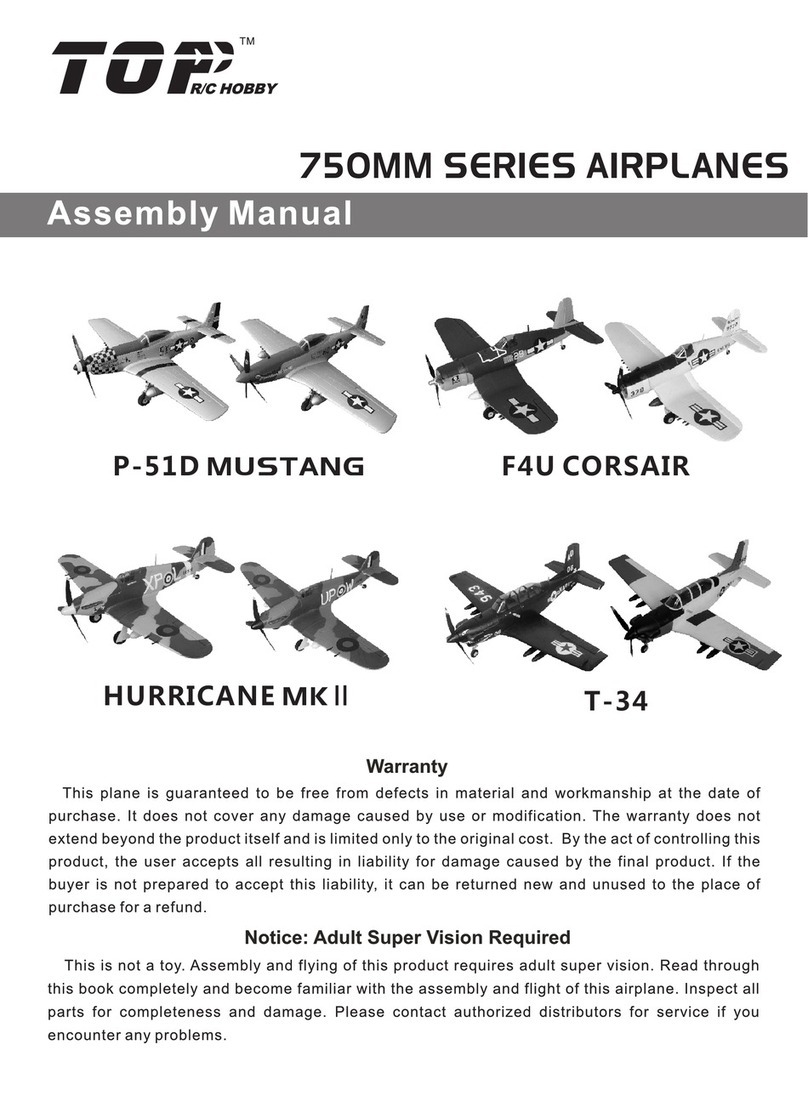
Top R/C Hobby
Top R/C Hobby F4U Corsair Assembly manual

PLAYTIVE JUNIOR
PLAYTIVE JUNIOR 303670 Instructions for use
